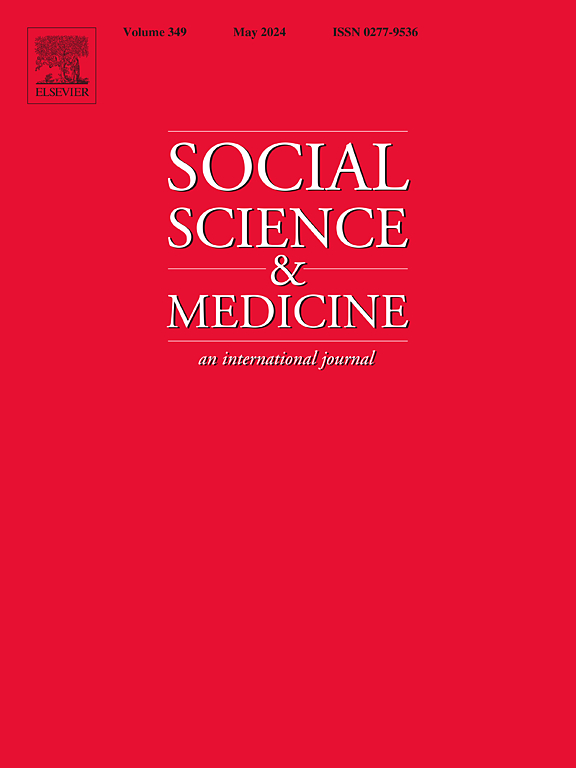Chronic pain prevalence and trends in urban, suburban, and rural areas amongAmerican adults aged 55+, 1998–2022
IF 5
2区 医学
Q1 PUBLIC, ENVIRONMENTAL & OCCUPATIONAL HEALTH
引用次数: 0
Abstract
Rural-urban health disparities in the United States are large and persistent, yet most surveillance efforts focus on mortality and disability. Monitoring rural-urban trends in pain, a major but overlooked indicator of population health, remains understudied. Given changes in demographics and resources of urban, suburban, and rural areas since the turn of the 21st century, which may have altered place-based differences in pain prevalence. Using nationally representative data from the Health and Retirement Study of 35,230 adults aged 55 and older (n = 206,600 person-wave observations), we estimated pain prevalence and trends across urban, suburban, and rural areas from 1998 to 2022. We assessed variation by age, sex/gender, race and ethnicity, and census region. Over 24 years, pain prevalence increased by 70 % (Prevalence Ratio [PR] = 1.70, 95 % Confidence Interval [CI]: 1.64, 1.75) and was consistently highest in rural areas and lowest in urban areas. However, pain prevalence rose most sharply in suburbs as compared to both rural and urban areas (suburban and time interaction vs. rural areas: PR = 1.08, 95 % CI: 1.00, 1.17). Suburban pain prevalence was similar to urban levels in 1998 but converged with that of rural levels by 2022. Stratified analyses revealed broadly similar patterns across demographic and regional groups, with particularly rapid increases among suburban populations in the South. These findings highlight nationwide increases in chronic pain, with suburban areas emerging as new “hotspots” alongside rural areas. Given that pain is a leading cause of disability and functional decline, monitoring place-based trends is essential for addressing this growing public health concern.
1998-2022年美国55岁以上成年人在城市、郊区和农村地区的慢性疼痛患病率和趋势。
在美国,城乡健康差距巨大且持续存在,但大多数监测工作都集中在死亡率和残疾上。监测城乡疼痛趋势(人口健康的一个主要但被忽视的指标)仍未得到充分研究。21世纪以来,城市、郊区和农村地区的人口结构和资源发生了变化,这可能改变了疼痛患病率的地方差异。使用来自35230名55岁及以上成年人的健康与退休研究的全国代表性数据(n = 206600人波观察),我们估计了1998年至2022年城市、郊区和农村地区的疼痛患病率和趋势。我们评估了年龄、性别、种族和民族以及人口普查地区的差异。24年间,疼痛患病率增加了70%(患病率比[PR] = 1.70, 95%可信区间[CI]: 1.64, 1.75),农村地区的疼痛发生率最高,城市地区的疼痛发生率最低。然而,与农村和城市地区相比,郊区的疼痛患病率上升幅度最大(郊区和时间相互作用与农村地区:PR = 1.08, 95% CI: 1.00, 1.17)。郊区疼痛患病率在1998年与城市水平相似,但到2022年与农村水平趋同。分层分析显示,人口和区域群体的模式大致相似,南方郊区人口的增长尤其迅速。这些发现强调了全国范围内慢性疼痛的增加,郊区与农村地区一起成为新的“热点”。鉴于疼痛是导致残疾和功能下降的主要原因,监测基于地点的趋势对于解决这一日益严重的公共卫生问题至关重要。
本文章由计算机程序翻译,如有差异,请以英文原文为准。
求助全文
约1分钟内获得全文
求助全文
来源期刊

Social Science & Medicine
PUBLIC, ENVIRONMENTAL & OCCUPATIONAL HEALTH-
CiteScore
9.10
自引率
5.60%
发文量
762
审稿时长
38 days
期刊介绍:
Social Science & Medicine provides an international and interdisciplinary forum for the dissemination of social science research on health. We publish original research articles (both empirical and theoretical), reviews, position papers and commentaries on health issues, to inform current research, policy and practice in all areas of common interest to social scientists, health practitioners, and policy makers. The journal publishes material relevant to any aspect of health from a wide range of social science disciplines (anthropology, economics, epidemiology, geography, policy, psychology, and sociology), and material relevant to the social sciences from any of the professions concerned with physical and mental health, health care, clinical practice, and health policy and organization. We encourage material which is of general interest to an international readership.
 求助内容:
求助内容: 应助结果提醒方式:
应助结果提醒方式:


